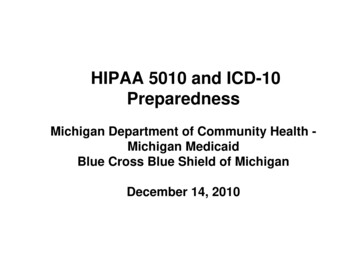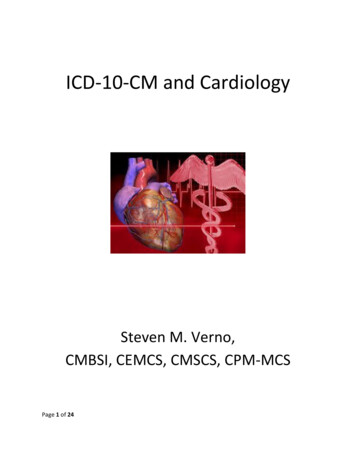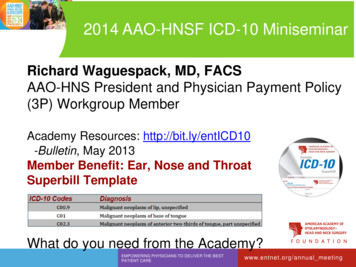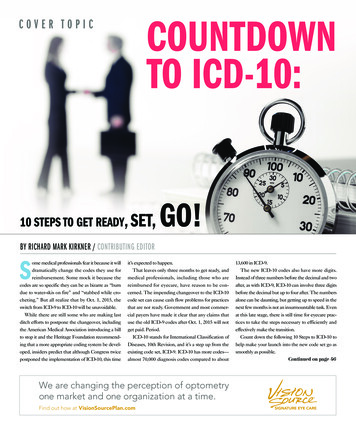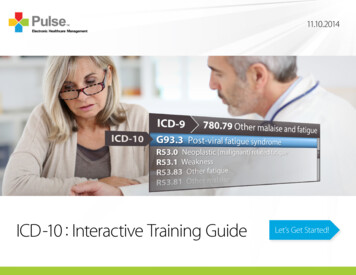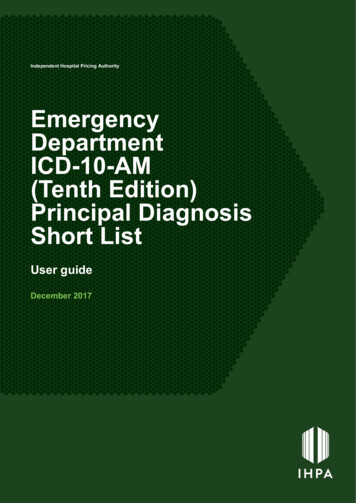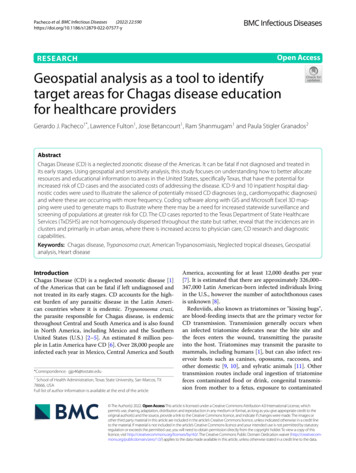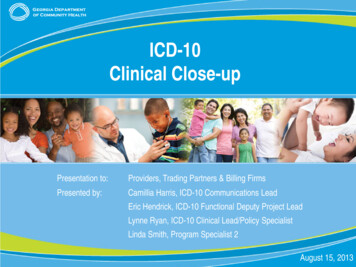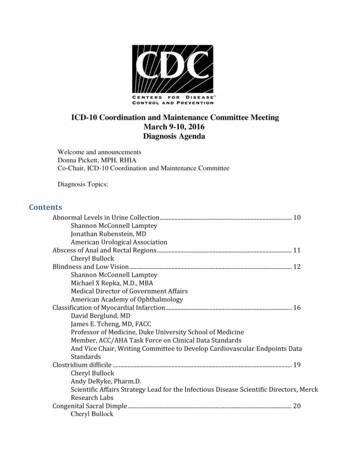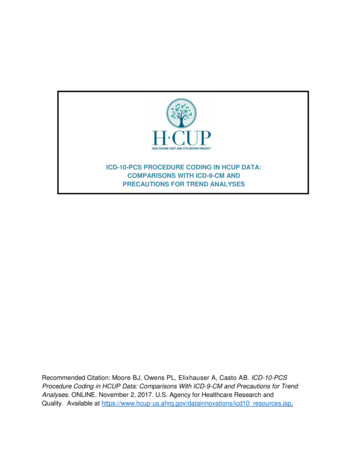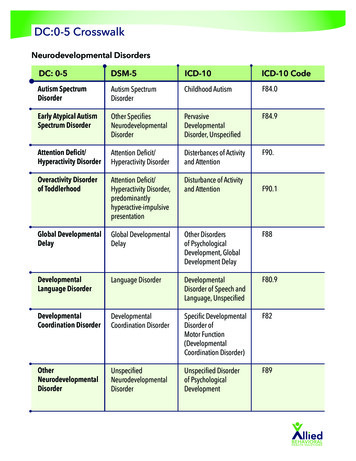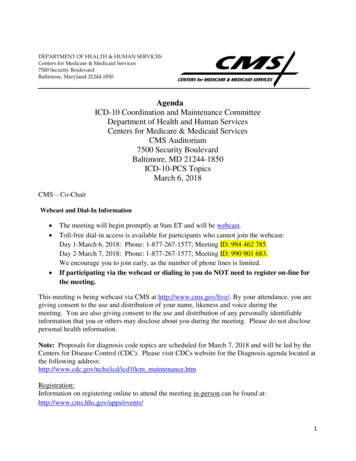
Transcription
DEPARTMENT OF HEALTH & HUMAN SERVICESCenters for Medicare & Medicaid Services7500 Security BoulevardBaltimore, Maryland 21244-1850AgendaICD-10 Coordination and Maintenance CommitteeDepartment of Health and Human ServicesCenters for Medicare & Medicaid ServicesCMS Auditorium7500 Security BoulevardBaltimore, MD 21244-1850ICD-10-PCS TopicsMarch 6, 2018CMS – Co-ChairWebcast and Dial-In Information The meeting will begin promptly at 9am ET and will be webcast.Toll-free dial-in access is available for participants who cannot join the webcast:Day 1-March 6, 2018: Phone: 1-877-267-1577; Meeting ID: 994 462 785.Day 2-March 7, 2018: Phone: 1-877-267-1577; Meeting ID: 990 901 683.We encourage you to join early, as the number of phone lines is limited.If participating via the webcast or dialing in you do NOT need to register on-line forthe meeting.This meeting is being webcast via CMS at http://www.cms.gov/live/. By your attendance, you aregiving consent to the use and distribution of your name, likeness and voice during themeeting. You are also giving consent to the use and distribution of any personally identifiableinformation that you or others may disclose about you during the meeting. Please do not disclosepersonal health information.Note: Proposals for diagnosis code topics are scheduled for March 7, 2018 and will be led by theCenters for Disease Control (CDC). Please visit CDCs website for the Diagnosis agenda located atthe following address:http://www.cdc.gov/nchs/icd/icd10cm maintenance.htmRegistration:Information on registering online to attend the meeting in-person can be found at:http://www.cms.hhs.gov/apps/events/1
*If participating via the webcast or dialing in, and not attending in-person, you do NOT needto register on-line for the meeting.For questions about the registration process, please contact Mady Hue at 410-786-4510 ormarilu.hue@cms.hhs.gov or Noel Manlove at 410-786-5161 or noel.manlove@cms.hhs.gov.Introductions and OverviewSonghai Barclift, MDICD-10-PCS Topics:1. Irreversible ElectroporationPages 11-12Noel ManloveRobert C.G. Martin, II, MD, PhD, FACSSam & Lolita Weakley Endowed Chair, SurgicalOncologyVice-Chair of the Dept of Surgery for ResearchDirector, Division of Surgical OncologyProfessor of SurgeryDirector, Upper GI & HPB Multi-Disciplinary ClinicAcademic Advisory DeanUniversity of Louisville2. Cell Suspension AutograftingPages 13-15Noel ManloveWilliam L. Hickerson, MD, FACSDirector, Firefighters Burn CenterRegional One Health, Memphis TNProfessor of Plastic SurgeryUniversity of Tennessee Health Science Center3. Insertion of the Remedē Phrenic Nerve Stimulation SystemPages 16-18Chava SheffieldSanjaya Gupta, MDSpencer B. Bailey, MBA, CPC4. Endovascular Bypass of Lower ExtremityArteriesPages 19-21Chava SheffieldDavid Deaton, MD, FACSChief Medical Officer, SyntactxVascular Surgeon, University of South Carolina5. Implantation of Multi-functionNetworked NeuroprosthesisPages 22-24Chava SheffieldHarry Hoyen, MDChief, Hand ServiceDepartment of OrthopedicsMetroHealth Medical CenterCleveland, Ohio2
6. Partial Knee Joint Replacement; FemoralModular Head; and Articulating Spacerfor Hip and Knee JointsPages 25-29Michelle JoshuaFrank R. Voss, MDCoding Representative for AAHKSand AAOS (CPT)7. Endovascular Thrombectomy ofIntracranial and Extracranial ArteriesPages 30-32Mady HueAnsaar Rai, MDVice Chairman RadiologyWest Virginia University Hospitals8. Robotic Water Resection of the ProstatePages 33-34Michelle JoshuaEugene V. Kramolowsky, MD MSHAUrologist, Virginia Urology, Richmond, VA9. Administration of PlazomicinPages 35-36Michelle JoshuaPamela Hawn, Pharm DDirector, Medical Scientist10. Percutaneous Extracorporeal MembraneOxygenation (ECMO) forCardiopulmonary InsufficiencyPages 37-38Mady HueGeorge W. Vetrovec, MD, MACC, MSCAIProfessor Emeritus, VCU Pauley Heart CenterVirginia Commonwealth UniversityRichmond, Virginia11. Spinal Fusion with HydroxyapatiteEnhanced Interbody Fusion DevicePages 39-41Michelle JoshuaJohn Devine, PhDManaging Director, Invibio Biomaterial Solutions12. Administration of GIAPREZAPages 42-43Michelle JoshuaTerry Dettling, BSN, JD, MPH13. Transfer of Prepuce for ReconstructionPages 44-45Mady HueAmber Davidson, RHIT, CCS, CCS-PSpecialist, Health Information DataChildren’s Hospital14. Section X, Addenda and Key UpdatesPages 46-55Rhonda Butler , 3MRegistering for the meeting:Registration for the September 11-12, 2018 ICD-10 Coordination and Maintenance Committeemeeting opens on August 3, 2018. If participating by Livestream webcast or dialing in you donot need to register online.3
Continuing Education Credits:Continuing education credits may be awarded by the American Academy of Professional Coders(AAPC) or the American Health Information Management Association (AHIMA) for participationin CMS ICD-10 Coordination and Maintenance (C&M) Committee Meeting Conference Calls,Meetings and Webcasts.Continuing Education Information for American Academy of Professional Coders (AAPC)If you have attended or are planning to attend a CMS ICD-10 Coordination and Maintenance(C&M) Committee Meeting Conference Call, you should be aware that CMS does not providecertificates of attendance for these calls. Instead, the AAPC will accept your e-mailed confirmationand call description as proof of participation. Please retain a copy of your e-mailed confirmationfor these calls as the AAPC will request them for any conference call you entered into your CEUTracker if you are chosen for CEU verification. Members are awarded one (1) CEU per hour ofparticipation.Continuing Education Information for American Health Information Management Association(AHIMA)AHIMA credential-holders may claim 1 CEU per 60 minutes of attendance at an educationalprogram. Maintain documentation about the program for verification purposes in the event of anaudit. A program does not need to be pre-approved by AHIMA, nor does a CEU certificate need tobe provided, in order to claim AHIMA CEU credit. For detailed information about AHIMA’s CEUrequirements, see the Recertification Guide on AHIMA’s web site.Please note: The statements above are standard language provided to CMS by the AAPC andthe AHIMA. If you have any questions concerning either statement, please contact therespective organization, not CMS.4
ICD-10 TIMELINEA timeline of important dates in the ICD-10 process is described below:March 6-7, 2018ICD-10 Coordination and Maintenance Committee Meeting.Those who wish to attend the ICD-10 Coordination and MaintenanceCommittee meeting must have registered for the meeting onlineby February 23, 2018. You must bring an official form of pictureidentification (such as a driver’s license) in order to be admitted tothe building.In compliance to The Real ID Act, enacted in ) the followingstates/territories: Maine, Minnesota, Missouri, Montana andWashington State will not gain access into any Federal Agenciesusing the above states driver’s license or ID. This means CMSvisitors from these states/territories will need to provide alternativeproof of identification (such as a passport) to gain entrance intoBaltimore-based and Bethesda CMS buildings, as well as theHumphrey Building in Washington.Because of increased security requirements, those wishing to attendthe March 6-7, 2018 ICD-10 Coordination and MaintenanceCommittee meeting must register for the meeting online ndees must register online by February 23, 2018; failure todo so may result in lack of access to the meeting.March 2018Webcast of the March 6-7, 2018 ICD-10 Coordination andMaintenance Committee meeting will be posted on the CMSwebpage as oviderDiagnosticCodes/meetings.htmlApril 1, 2018There were no requests for ICD-10 codes to capture new diagnosesor new technology for implementation on April 1, 2018. Therefore,there will be no new ICD-10 diagnosis or procedure codesimplemented on April 1, 2018.April 6, 2018Deadline for receipt of public comments on proposed new codesdiscussed at the March 6-7, 2018 ICD-10 Coordination andMaintenance Committee meetings for implementation onOctober 1, 2018.5
April 2018Notice of Proposed Rulemaking to be published in the FederalRegister as mandated by Public Law 99-509. This notice will includereferences to the finalized FY 2019 ICD-10-CM diagnosis and ICD10-PCS procedure codes to date. It will also include proposedrevisions to the MS-DRG system based on ICD-10-CM/PCS codeson which the public may comment. The proposed rule can beaccessed rvicePayment/AcuteInpatientPPS/index.html?redirect /AcuteInpatientPPS/IPPS/list.aspJune 2018Final addendum posted on web pages as follows:Diagnosis addendum - http://www.cdc.gov/nchs/icd/icd10cm.htmProcedure addendum lJuly 13, 2018Deadline for requestors: Those members of the public requestingthat topics be discussed at the September 11-12, 2018 ICD-10Coordination and Maintenance Committee meeting must havetheir requests submitted to CMS for procedures and NCHS fordiagnoses.August 1, 2018Hospital Inpatient Prospective Payment System final rule to bepublished in the Federal Register as mandated by Public Law 99-509.This rule will also include links to all the final codes to beimplemented on October 1, 2018.This rule can be accessed rvicePayment/AcuteInpatientPPS/index.html?redirect /AcuteInpatientPPS/IPPS/list.aspAugust 2018Tentative agenda for the Procedure part of the September 11-12,2018 ICD-10 Coordination and Maintenance Committee meeting willbe posted on the CMS webpage at s.htmlTentative agenda for the Diagnosis part of the September 11-12,2018 ICD-10 Coordination and Maintenance Committee meeting willbe posted on the NCHS webpage at http://www.cdc.gov/nchs/icd/icd10cm maintenance.htmFederal Register notice for the September 11-12, 2018 ICD-10Coordination and Maintenance Committee meeting will bepublished. This will include the tentative agenda.6
August 3, 2018On-line registration opens for the September 11-12, 2018 ICD-10Coordination and Maintenance Committee meeting ember 3, 2018Because of increased security requirements, those wishing to attendthe September 11-12, 2018 ICD-10 Coordination and MaintenanceCommittee meeting must register for the meeting online ndees must register online by September 3, 2018; failure todo so may result in lack of access to the meeting.September 11-12, 2018ICD-10 Coordination and Maintenance CommitteeMeeting.Those who wish to attend the ICD-10 Coordination and MaintenanceCommittee meeting must have registered for the meeting onlineby September 3, 2018. You must bring an official form of pictureidentification (such as a driver’s license) in order to be admitted tothe building.September 2018Webcast of the September 11-12, 2018 ICD-10 Coordination andMaintenance Committee meeting will be posted on the CMSwebpage as oviderDiagnosticCodes/meetings.htmlOctober 1, 2018New and revised ICD-10-CM and ICD-10-PCS codes go into effectalong with DRG changes. Final addendum available on web pages asfollows:Diagnosis addendum - http://www.cdc.gov/nchs/icd/icd10cm.htmProcedure addendum r 12, 2018Deadline for receipt of public comments on proposed new codesdiscussed at the September 11-12, 2018 ICD-10 Coordination andMaintenance Committee meetings for implementation on April 1,2019.November 2018Any new ICD-10 codes required to capture new technology that willbe implemented on the following April 1 will be announced.Information on any new codes to be implemented April 1, 2019 willbe posted on the following tp://www.cms.gov/Medicare/Coding/ICD10/November 12, 2018Deadline for receipt of public comments on proposed new codesand revisions discussed at the September 11-12, 2018 ICD-107
Coordination and Maintenance Committee meetings forimplementation on October 1, 2019.8
Introductions and Overview ICD-10 Coordination & Maintenance (C&M) Committee is a public forum onICD-10-CM & ICD-10-PCS code updatesCMS & CDC Co-chair the meetings– CMS has lead on procedure issues– CDC has lead on diagnosis issuesCoding proposals requested by the public are presented and public given opportunityto comment Code ProposalsICD-10-PCS code proposals being consideration for implementationon October 1, 2018No final decisions made at the meetingCMS will describe options and recommendations to facilitate discussionPublic can comment at meeting and send written comments Comments on Code ProposalsSubmit written comments by– April 6, 2018 for codes discussed at March 6-7, 2018 C&M meetingProcedure comments to CMS (new is comments to Donna Pickett, CDC nchsicd10cm@cdc.gov Proposed and Final RulesApril 2018 – Notice of Proposed Rulemaking, IPPS– Includes ICD-10-CM/PCS diagnosis and procedure updates approvedprior to March 2018 C&M meetingAugust 1, 2018 – Final rule with links to final codes to be implementedon October 1, 2018– Includes any additional codes approved from March 6-7, 2018 C&Mmeeting AddendumJune 2018 – Final code updates and addendum posted– FY 2019 ICD-10-PCS 10/index.html– FY 2019 ICD-10-CM 9
September 11-12, 2018 C&M Code RequestsJuly 13, 2018– Deadline for submitting topics for September 11-12, 2018 C&Mmeeting– Procedure requests to CMS (new address)ICDProcedureCodeRequest@cms.hhs.gov– Diagnosis requests to Donna Pickett, CDC– nchsicd10cm@cdc.govPublic ParticipationFor this meeting the public may participate in three ways:– Attend public C&M meeting– Listen to proceedings through free conference lines– Participate through a free livestream webcastCMS & CDC hope this provides greater opportunity for public participationWritten CommentsNo matter how you participate – please send written comments by– April 6, 2018 for codes to be implemented on October 1, 2018– Procedure comments to CMS ICDProcedureCodeRequest@cms.hhs.gov– Diagnosis comments to Donna Pickett, CDC nchsicd9@cdc.govICD-10-PCS Codes ImplementationICD-10-PCS codes discussed today under consideration for October 1, 2018implementation10
Irreversible Electroporation (IRE)Issue: There is not a unique ICD-10-PCS code to describe hepatic and/or pancreatic cancer celldestruction using Irreversible Electroporation (IRE). This topic was addressed at the March 2015ICD-10 C&M Meeting and a new code was not approved. The requestor asked that this topic bebrought back for reconsideration. The requestor has also asked that detail be added to the ICD-10PCS for procedures that use three other specific ablative techniques: radiofrequency, microwave,and cryotherapy.New Technology Application? NoBackground: Irreversible electroporation (IRE) is a new tissue ablation technique in which microto millisecond electrical pulses are delivered to undesirable tissue to produce cell death throughirreversible cell membrane permeabilization. IRE affects only the cell membrane and no otherstructure in the tissue. The current ICD-10-PCS codes do not identify the specific technique thatinduces tumor cell membrane porosity thereby causing cancer cell death (via apoptosis).Locally advanced hepatic and pancreatic cancer patients have limited options for long term durabledisease control. Ablation techniques such as cryoablation and radiofrequency ablation are currenttreatment options. However, these procedures have been associated with destruction of adjacenthealthy tissue. In contrast, IRE therapy can be well tolerated with rapid resolution of hepatic and/orpancreatic inflammation and preservation of healthy tissue and vascular structures.Current Coding: The IRE tissue ablation technique used for hepatic and/or pancreatic cancer celldestruction can be reported using the codes in table 0F5, Destruction of Hepatobiliary System andPancreas. Under ICD-10-PCS, ablation is a term included in the root operation Destruction as,“physical eradication of all or a portion of a body part by the direct use of energy, force, or adestructive agent”.Medical and Surgical 0Body SystemFOperation5Body Part0 Liver1 Liver, Right Lobe2 Liver, Left LobeG PancreasMedical and SurgicalHepatobiliary System and PancreasDestruction: Physical eradication of all or a portion of a body part by the direct use ofenergy, force, or a destructive agentApproachDeviceQualifier0 Open3 Percutaneous4 Percutaneous EndoscopicZ No DeviceZ No QualifierCoding OptionsOption 1. Do not create new codes for Irreversible Electroporation. Continue using codes insection 0F5 as indicated above.11
Option 2. Create new qualifier value F (Irreversible Electroporation) in table 0F5 Destruction ofHepatobiliary System and Pancreas, to identify IRE versus other destruction techniques.Section0Body System FOperation5Medical and SurgicalHepatobiliary System and PancreasDestruction: Physical eradication of all or a portion of a body part by the direct use of energy, force,or a destructive agentBody PartApproachDeviceQualifier0 Liver0 Open1 Liver, Right LobeADD F Irreversible Electroporation3 PercutaneousZ No Device2 Liver, Left LobeZ No Qualifier4 Percutaneous EndoscopicG PancreasOption 3. Create new qualifier value Irreversible Electroporation in table 0F5 Destruction ofHepatobiliary System and Pancreas, to identify IRE versus other destruction techniques. Inaddition, create new qualifier values Radiofrequency, Microwave, and Cryotherapy in table ofsection 0F5 Destruction of Hepatobiliary System and Pancreas, to identify other specificdestruction techniques.Section0Body System FOperation5Medical and SurgicalHepatobiliary System and PancreasDestruction: Physical eradication of all or a portion of a body part by the direct use of energy, force,or a destructive agentBody PartApproachDeviceQualifierADD F Irreversible Electroporation0 Liver0 OpenADD G Radiofrequency1 Liver, Right Lobe3 PercutaneousZ No DeviceADD H Microwave2 Liver, Left Lobe4 Percutaneous EndoscopicADD J CryotherapyG PancreasZ No QualifierCMS Recommendation: We are interested in receiving input from the public on these options. Asstated earlier, this topic was initially presented in the March 2015 ICD-10 Coordination &Maintenance Committee meeting. Following the March 2015 meeting, CMS received publiccomments opposing the creation of new codes. The commenters stated that the current ICD-10PCS root operation Destruction correctly captures this procedure. The commenters also noted thatphysician documentation of this procedure will not clearly distinguish the specific technique ofirreversible electroporation from other techniques used for tumor ablation. Therefore, if a uniquecode were created, it would be difficult for coders to determine when to assign the code for thistechnology.Interim Coding Advice: In the interim, continue to assign codes from table 0F5 as described incurrent coding.12
Cell Suspension AutograftingIssue: There currently is no unique ICD-10-PCS code to capture cell suspension epithelialautografts.New Technology Application? No.Food & Drug Administration (FDA) Approved? No. An application for Pre-Market Approvalwas submitted to the FDA in September 2017.Background: ReCell is a type of epithelial autograft that can be used for large wounds suchas major burns. It is also currently being considered for additional acute and chronic types ofwounds. The procedure involves harvesting a split-thickness skin sample from a healthydonor site on the patient. This sample is then placed into a warm enzyme-containingincubator where it biochemically separates the epidermis from the dermis. After about 15 to20 minutes, the sample is removed and its surface is scraped to separate the cells from thetissue. This creates a mixed population of cells, primarily keratinocytes and fibroblasts butalso including melanocytes, Langerhans cells, and epidermal basal cells. The cells are thensuspended in a buffer solution and filtered to remove debris. The result is a regenerativeepithelial cell suspension that can be immediately applied to the prepared wound via a spraytechnique or a drip technique.Depending on the extent of the injury, the cell suspension autograft can be applied alone orin conjunction with another skin graft. The entire process takes place in the operating room.It is performed by the surgeon, sometimes with assistance by a nurse or technician under thesurgeon's supervision. According to the requester, the surgeon is present and exclusivelyengaged throughout.Current Coding: Report the split-thickness skin harvest using the appropriate body part in table0HB, Excision of Skin and Breast body system and the qualifier Z, to indicate that the skin excisionis therapeutic, not diagnostic.SectionBody SystemOperation0 Medical and SurgicalH Skin and BreastB Excision: Cutting out or off, without replacement, a portion of a body partBody Part0 Skin, Scalp1 Skin, Face2 Skin, Right Ear3 Skin, Left Ear4 Skin, Neck5 Skin, Chest6 Skin, Back7 Skin, AbdomenApproachX ExternalDeviceZ No DeviceQualifierX DiagnosticZ No Qualifier13
8 Skin, Buttock9 Skin, PerineumA Skin, InguinalB Skin, Right Upper ArmC Skin, Left Upper ArmD Skin, Right Lower ArmE Skin, Left Lower ArmF Skin, Right HandG Skin, Left HandH Skin, Right Upper LegJ Skin, Left Upper LegK Skin, Right Lower LegL Skin, Left Lower LegM Skin, Right FootN Skin, Left FootQ Finger NailR Toe NailFacilities can report the application of cell suspension autografting using the following ICD-10PCS code:3E00XGC Introduction of Other Therapeutic Substance into Skin and Mucous Membranes,External ApproachCoding OptionsOption 1. Do not create new codes for the application of cell suspension autografting. Continue touse the current codes as described above.Option 2. Create new qualifier Partial Thickness, Cell Suspension in table 0HR, Replacement ofSkin and Breast body system, applied to the skin body part values and the device value AutologousTissue Substitute, to identify cell suspension autografting.Section0 Medical and SurgicalBody SystemH Skin and BreastOperationR Replacement: Putting in or on biological or synthetic material that physically takes the place and/orfunction of all or a portion of a body partBody Part0 Skin, Scalp1 Skin, Face2 Skin, Right Ear3 Skin, Left Ear4 Skin, Neck5 Skin, Chest6 Skin, Back7 Skin, Abdomen8 Skin, Buttock9 Skin, PerineumA Skin, InguinalApproachDeviceX External 7 Autologous Tissue SubstituteQualifierADD 2 Partial Thickness, Cell Suspension3 Full Thickness4 Partial Thickness14
B Skin, Right Upper ArmC Skin, Left Upper ArmD Skin, Right Lower ArmE Skin, Left Lower ArmF Skin, Right HandG Skin, Left HandH Skin, Right Upper LegJ Skin, Left Upper LegK Skin, Right Lower LegL Skin, Left Lower LegM Skin, Right FootN Skin, Left FootOption 3. Create a new code in Section X to identify cell suspension autografting. Create newDevice/Substance/Technology value Autologous Epithelial Cell Suspension in table XH0 for thebody part value Skin.SectionX New TechnologyBodySystemH Skin, Subcutaneous Tissue, Fascia and BreastOperation0 Introduction: Putting in or on a therapeutic, diagnostic, nutritional, physiological, or prophylacticsubstance except blood or blood productsBody PartApproachDevice / Substance / TechnologyQualifierP SkinX ExternalL Autologous Epithelial Cell Suspension4 New Technology Group 4Option 4. Create a new code in the Administration section to identify cell suspension autografting.Create new qualifier value Autologous Epithelial Cell Suspension in table 3E0 for the body partvalue Skin and Mucous Membranes, applied to the substance value Other Therapeutic Substanceand the approach value External Approach.Section3 AdministrationBody SystemE Physiological Systems and Anatomical RegionsOperation0 Introduction: Putting in or on a therapeutic, diagnostic, nutritional, physiological, or prophylacticsubstance except blood or blood productsBody System / RegionApproachSubstanceQualifierC Other Substance0 Skin and MucousG Other TherapeuticX ExternalADD L Autologous Epithelial CellMembranesSubstanceSuspensionCMS recommendation: CMS seeks public input on these options.Interim Coding Advice: Continue to report autograft harvest and application of cell suspensionautografting as shown in current coding above.15
Insertion of the Remedē Phrenic Nerve Stimulation SystemIssue: The Remedē System is an implantable nerve stimulator used to treat moderate to severecentral sleep apnea (CSA) in adults. The device consists of an implantable pulse generator (IPG),sensing lead, stimulation lead, and patient programmer. Existing ICD-10-PCS codes describe theinsertion of all of the system elements except insertion of the stimulating lead when placed into theleft pericardiophrenic vein.New Technology Application? Yes, an application has been submitted for FY 2019.Food & Drug Administration (FDA) Approved? Yes. The Remedē System received premarketapproval on October 6, 2017.Background: Central sleep apnea (CSA) is a chronic form of sleep disordered breathingcharacterized by the temporary withdrawal of brainstem-driven respiratory drive that results incessation of breathing, hypoxia, and sympathetic surges which can lead to cardiovascularcomplications and is associated with poor outcomes. There are currently no effective alternativetreatments available for moderate to severe CSA. It is increasingly recognized as a comorbidity ina number of disorders, including heart failure (HF), valvular disease, and atrial fibrillation.It is estimated that CSA affects nearly 40% of patients with heart failure and can lead to excessivedaytime drowsiness, impaired cognitive function, and reduced exercise capacity. Studies haveshown that CSA can lead to the worsening of heart failure and is associated with an increased riskof death.Respicardia, Inc. has developed the Remedē System, which is used to treat adult patients withmoderate to severe CSA. The Remedē System is designed to improve cardiovascular health byrestoring a more normal breathing pattern during sleep in patients with CSA.The Remedē System implantable pulse generator (IPG) is implanted via a submuscular orsubcutaneous approach in the pectoral region. The sensing lead is inserted into the azygos vein.The stimulation lead is inserted unilaterally, either into the right innominate (brachiocephalic) orinto the left pericardiophrenic veins, which are anatomically adjacent to the right and left phrenicnerve, respectively.Current Coding: The following ICD-10-PCS codes are used to report insertion of thecomponents of the Remedē System:0JH60DZ Insertion of Multiple Array Stimulator Generator into Chest Subcutaneous Tissue andFascia, Open Approach, for insertion of the implantable pulse generator in the pectoral regionAND05H03MZ Insertion of Neurostimulator Lead into Azygos Vein, Percutaneous Approach, fortransvenous insertion of sensing lead in the azygos veinAND05H33MZ Insertion of Neurostimulator Lead into Right Innominate Vein, Percutaneous Approach,for transvenous insertion of the stimulator lead in the right innominate (brachiocephalic) veinOR16
05H43MZ Insertion of Neurostimulator Lead into Left Innominate Vein, Percutaneous Approach,for transvenous insertion of the stimulator lead in the left pericardiophrenic vein.Note: According to the ICD-10-PCS coding guideline B4.2, “Where a specific branch of a bodypart does not have its own body part value in PCS, the body part is typically coded to the closestproximal branch that has a specific body part value.” The left innominate vein is the closestproximal branch of the left pericardiophrenic vein.Coding OptionsOption 1. Do not create new codes for the insertion of the Remedē System stimulating lead intothe left pericardiophrenic vein. Continue to code as above in current coding.Option 2. In table 05H, Insertion of the Upper Veins body system, create new qualifier valuePericardiophrenic Vein, for the body part value Innominate Vein, Left and the device valueNeurostimulator Lead.Section0 Medical and SurgicalBody System5 Upper VeinsOperationH Insertion: Putting in a nonbiological appliance that monitors, assists, performs, or prevents aphysiological function but does not physically take the place of a body partBody Part4 Innominate Vein, LeftApproach0 Open3 Percutaneous4 Percutaneous EndoscopicDeviceQualifierM Neurostimulator LeadADD 0 Pericardiophrenic VeinZ No QualifierOption 3. Create new codes in section X, New Technology, to identify the two major componentsof the Remedē phrenic nerve stimulation system. In table XHH, Insertion of Skin, SubcutaneousTissue, Fascia and Breast, create new device value Implantable Phrenic Nerve Stimulation Device,Generator for the body part value Subcutaneous Tissue and Fascia, Chest, to capture insertion ofthe implantable pulse generator.SectionX New TechnologyBody SystemH Skin, Subcutaneous Tissue, Fascia and BreastOperationH Insertion: Putting in a nonbiological appliance that monitors, assists, performs, or prevents aphysiological function but does not physically take the place of a body partBody PartApproach0 OpenADD 6 Subcutaneous Tissue and3 PercutaneousFascia, ChestDevice / Substance / TechnologyADD M Implantable Phrenic NerveStimulation Device, GeneratorQualifier4 New TechnologyGroup 4In table X2H, Insertion of Cardiovascular System, create new device value Implantable PhrenicNerve Stimulation Device, Leads for the body part value Azygos Vein and Right Innominate Veinor Left Per
2 *If participating via the webcast or dialing in, and not attending in-person, you do NOT need to register on-line for the meeting. For questions about the registration process, please contact Mady Hue at 410-786-4510 or marilu.hue@cms.hhs.gov or Noel Manlove at 410-786-5161 or noel.manlove@cms.hhs.gov.
